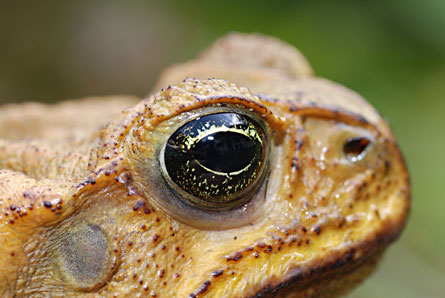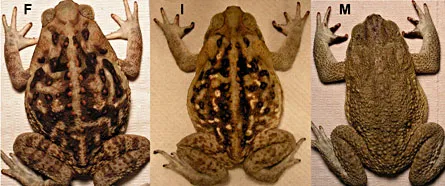Farm life turns male toads female
Toads studied over a wide area are most affected near agriculture
Among toads living in farm country, gents tend to resemble the gals — both inside and out. This doesn’t bode well for the hoppers impressing local ladies, much less fathering their tadpoles.


Toads and other amphibians throughout the world are under siege. Disease plagues many populations, while others suffer high rates of deformities or immune suppression. In some regions, species have simply vanished without a trace.
To investigate whether these problems might stem from some general stress associated with land development, rather than poisoning by chemicals, University of Florida biologists analyzed dozens of local adult cane toads (Bufo marinus). At least 20 were collected during summer nights on damp grass at each of five far-from-pristine sites in Florida. Some toads had been living in city suburbs, others at venues near anything from a little farming to heavy agriculture.
As hectares of farming in the toads’ vicinities increased, so did the proportion of males exhibiting a serious feminization, Krista A. McCoy and her colleagues report in an upcoming Environmental Health Perspectives.
If just land disturbance — to build roads, homes, shopping malls and the like — was a sufficient stressor, the effects on toads living near suburbs should be no different those on toads living near farms. That there was a difference suggests that something special about farming is to blame, such as the chemicals used on farms — many of which in isolation can cause feminization of amphibians and other animals.
At sites associated with heavy agriculture (where half to 97 percent of the nearby land was farmed), only about 40 percent of the males had typical he-toad gonads and coloring. An equal number were intersex animals, possessing both testes and ovaries.
Another 20 percent or so of the males at the two sites having the most agricultural activity appeared outwardly male. However, as the intersex animals did, these superficially normal males sported a maturing Bidder’s organ.
Like the human appendix, a toad’s Bidder’s tissue normally has no function. However, if males lose testicular function, a Bidder’s organ may suddenly mature into an ovary, observes wildlife endocrinologist Louis Guillette, a coauthor on the new study. His team found that Bidder’s organs in males from the agricultural regions were sometimes chock full of eggs (although their viability was never checked).
Feminized male toads had a female coloration, shorter forearms than normal males, and fewer nuptial pads (temporary features that develop on the fingers of males who are readying to mate). Levels of testosterone, the primary macho sex hormone, were especially low in male toads from sites near substantial farming — at about the same level seen in females.
“I’ve worked with this species,” says David Crews of the University of Texas at Austin, and “these are about the toughest amphibians in the world.” So he was impressed by the new data, which suggest that something about agriculture’s proximity — probably the runoff of pesticides or other farm chemicals — is “essentially remaking the individual,” inappropriately “resculpting” a male tadpole’s urogenital tract. It’s so muddled in intersex animals, he says, that they will likely never breed.
In lab studies by Tyrone Hayes of the University of California, Berkeley, the types of gross demasculinizing changes reported in the new study would make animals sterile, Hayes says. He has investigated gonadal changes in frogs exposed to feminizing agricultural chemicals, such as the weed-killer atrazine.
But malformed organs or a feminine appearance isn’t the only obstacle to mating, Hayes points out. Behavior can also be affected by chemical exposures. “Out of every trial we’ve done,” he says, “only two atrazine-treated males were ever able to even copulate.” Most weren’t interested. So he jokes that this chemical makes “a great male contraceptive.”
Although the Florida team does not speculate on what might have been in the tadpoles’ water to have feminized them, Hayes says that a primary suspect has to be “atrazine obviously.” It is a weed killer used by farmers, generally, but especially by those raising sugar cane, a primary crop in the heavily agricultural Florida settings where toads had been sampled.
Any reproductive remodeling of the male toads’ bodies likely also traces to additional chemicals, Hayes says. Work by his team and others has shown that with mixtures of agricultural chemicals, “you often get an enhancement of the [deleterious] effects seen with any one chemical alone.”
The study scanned an area that continuously moves from suburban to somewhat agricultural to very agricultural. This “clean” gradient allowed its authors to identify “dose-dependent” effects of farming on internal organs, hormones, and even outward appearance, observes Pamela Martin of Environment Canada in Burlington, Ontario. These changes “corroborated each other very well,” she adds, “making for a very convincing story.”
A paper by Martin’s team due out soon in Aquatic Toxicology will make a similar link between a region’s agricultural intensity and the feminization of local male amphibians — in this case northern leopard frogs.






